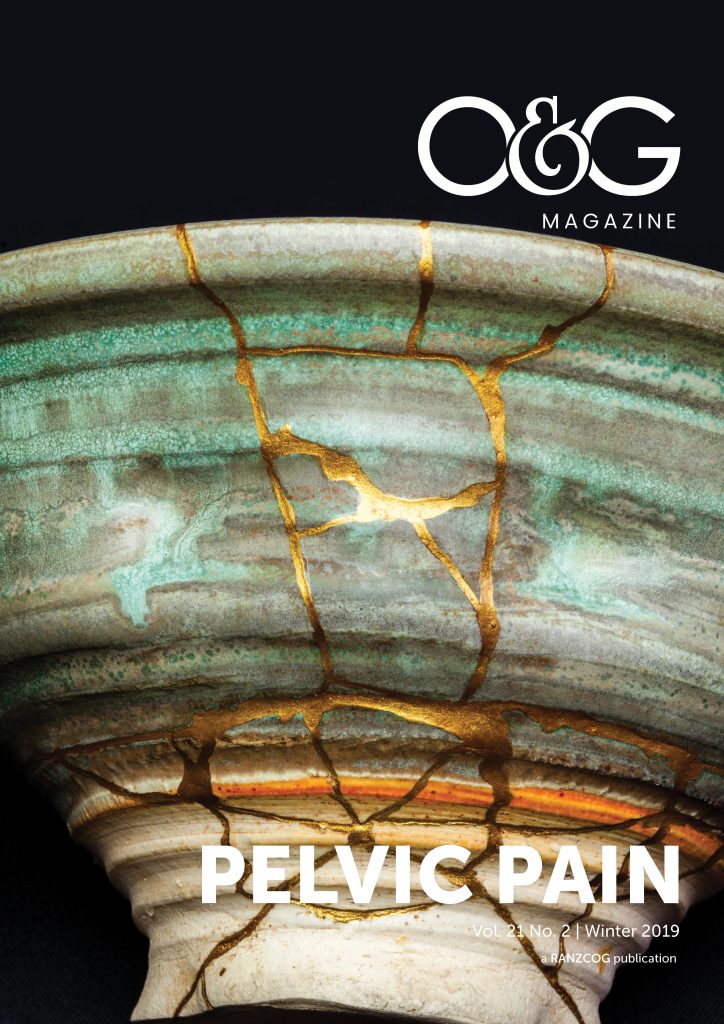Adolescents presenting with pelvic pain deserve a considered approach for several reasons. Firstly, by recognising and treating pain at an early stage, we can reduce the likelihood of a lifelong battle with chronic pain. We know that repeated or prolonged episodes of pain lead to central sensitisation and predispose to chronic/persistent pelvic pain.1 Most importantly, how pain is explained and the language that is used will significantly shape how the adolescent sees and copes with the pain that she is experiencing. Secondly, adolescence itself represents a time of self-discovery and growth, the crucial time in which a young woman is developing her sense of self and paving the way for the adult she will become. There is Australian evidence that 20–30 per cent of women with dysmenorrhea are missing school and activities, making it an important issue to address,2 not just for her current health and wellbeing, but for her future. Additionally, there are a few other specific causes of pelvic pain that typically present in adolescence, or even during childhood, that we will cover in this article.
Causes of pelvic pain in adolescents:
- dysmenorrhoea
- ovulation pain
- abdominal wall/pelvic floor
- ovarian cysts
- vulvodynia
- imperforate hymen
- Müllerian tract anomalies
- pelvic inflammatory disease (PID)
- acute pain, such as ovarian torsion, ectopic pregnancy, appendicitis, PID
- other causes, such as bladder, inflammatory bowel disease, constipation
A considered approach to pelvic pain in adolescents
A careful history should be taken with any consultation, including questions exploring HEADS (home/housing, education/employment, activities, drugs/depression, sexuality/suicide). Much can be gained by understanding the context and life of the young woman and her pain. Questions also need to cover the development of secondary sexual characteristics, if there has been a growth spurt, if and when menarche was achieved. Getting an idea of cycle length, duration, menstrual flow and when in the cycle she has pain will often help identify a cause. For example, pain two days before the period starts and for the first few days, but not at any other time of the month, associated with nausea, vomiting and diarrhoea is consistent with primary dysmenorrhoea.3
On the other hand, pain throughout the month with a palpable one-sided pelvic mass worse with a period might represent an obstructed uterine horn in an adolescent with a Müllerian tract abnormality. Pain may also be ongoing post an acute event, such as cyst rupture or haemorrhagic corpus luteum. Patients may also transition from experiencing intermittent pain to experiencing ongoing abdominal pelvic symptoms as a result of central sensitisation. Careful examination of the abdomen and, in particular, the abdominal wall to ascertain whether there are any trigger points will help identify a musculoskeletal cause. This can be done by asking the patient to lift their head off the bed (that is, tensing the abdominal wall) while examining the abdomen, known as Carnett’s sign. Bowel and bladder symptoms should also be discussed to identify any contributing factors. External genital examination should be performed with consent, especially in girls who have not yet achieved menarche but may have cyclical abdominal pain or an abdominal mass, to identify an imperforate hymen or a transverse vaginal septum. A sexual history should be taken without parental/carer presence, if possible, to assess other risk factors that may contribute to pelvic pain, such as previous history of sexual abuse/assault, risk factors for PID/pregnancy.
If dysmenorrhoea is not well controlled with simple analgesia, including nonsteroidal anti-inflammatory drugs (NSAIDs), or if associated with atypical features, such as pain persisting beyond the end of the menses and pain between menses, a pelvic ultrasound should be performed. Ultrasound can be useful to identify ovarian cysts or obstructive Müllerian anomalies. In addition, ultrasound can be better than laparoscopy for identifying some unusual adolescent problems, such as obstructed uterine horn/s that at laparoscopy might simply appear as a bicornuate uterus.
Blood tests are often of little value to investigate causes of pain in adolescence; however, if a patient has recurrent haemorrhagic cysts and/or heavy menstrual bleeding, history of easy bleeding/bruising or a strong family history, investigations for a bleeding disorder should be considered. This would include screening for Von Willebrand’s disease, full blood count and platelet function assay (PFA-100).
Table 1. Management of causes.
| General management | Identify likely cause Education Exercise, stretching, heat, mindfulness Multidisciplinary care should be considered for all complex patients Emotional support for parent and child including school supports and involvement of a psychologist Involve patient in management plan based on maturity level |
| Dysmenorrhoea | NSAIDs: regularly three times a day (TDS) at the onset of symptoms Tranexamic acid 1 g TDS to reduce blood loss Suppression of menses with hormonal therapies e.g. progesterone only pill, COCP, progesterone injection, or Levonorgestrel IUS If ongoing pain despite an adequate period of menstrual suppression and a specialist women’s imaging ultrasound ruling out other causes of pain, a laparoscopy should be considered |
| Ovulation pain | Track expected ovulation; use regular tranexamic acid and NSAIDs Ovulation suppression e.g. COCP, medroxyprogesterone injection, continuous progestogens |
| Abdominal wall / pelvic pain | Physiotherapy Injection with steroid and local anaesthetic – partly diagnostic, partly treatment Consider role of neuromodulators Involvement of paediatric pain team |
| Ovarian cysts | Identify type of cyst simple vs complex Monitoring: need repeat scan in 6–8 weeks Ovulation suppression if recurrent simple cysts If complex bloods, surgery as required |
| Vulvodynia | Avoid irritants Education/emotional support Neuromodulators that control symptoms >6 months before consideration of weaning e.g. Amitriptyline |
| Imperforate hymen | Surgical management |
| Müllerian anomalies | Specialist pelvic ultrasound +/- MRI Supress periods to control symptoms until ready for surgery Seek advice for optimal management from experienced gynaecologist Surgery to correct if/when appropriate |
| Pelvic Inflammatory disease | Antibiotics Education about safe sexual practice, including contact tracing Counsel long-term complications |
| Acute pain | Gynaecology review Pelvic ultrasound to rule out acute causes of pelvic pain, eg. torsion, ectopic pregnancy, cyst rupture |
| Other causes | Surgical, gastroenterology, adolescent medicine, urology as appropriate |
Dysmenorrhoea
Primary dysmenorrhoea in teenagers is common and can be associated with a range of associated symptoms that commonly include nausea, vomiting, diarrhoea, myalgia, headaches, dizziness and fainting. Some girls present with cyclical exacerbations of chronic fatigue, pain in other body parts, epilepsy, asthma and even anaphylaxis related to their periods. This tells us that the prostaglandins and pro-inflammatory cytokines produced to provoke endometrial shedding (which is known to be an inflammatory process)4 are potent and cause systemic effects. We know that by involving the patient in their management and explaining the physiology behind why they may feel pain, we can empower them to understand their condition better. An age-appropriate explanation of the process the body goes through during menstruation can be therapeutic in itself and is reassurance that the pain is not necessarily reflective of underlying pathology. Endometriosis (and even adenomyosis) should be considered as a differential diagnosis, but, in adolescents, first-line management should be education, pain management strategies and reduction of heavy menstrual bleeding/suppression of menses.
Vulval and genital pain
The occurrence of distressing nocturnal pain, waking the pre-pubertal child from sleep, raises the possibility of pinworms and should be treated with weekly mebendazole for three weeks.5 Vulvodynia commonly presents in childhood, but can be ongoing into adolescence. Presentations can include urinary symptoms (80 per cent), burning sensation, or a bubbly/ticklish feeling on the perineum/vulval area. It is also seen after a triggering event, such as urinary tract infection or vulvovaginitis. In the adolescent, the presentation may be inability to use tampons or dyspareunia. Careful history and subsequent examination using cotton swab test can aid diagnosis. External genitalia usually appear normal, but 94 per cent will have altered sensation at the vestibule on cotton swab test examination.6 Diagnostic delay is common and can be very distressing for the patient and family.
Special considerations for the use of hormonal therapies in adolescents
Medical treatment options for dysmenorrhoea are essentially the same in adolescents as they are in adults. First-line options include heat packs/stretching, simple analgesia and regular NSAIDs. For girls with pain uncontrolled by simple measures or seeking contraception, hormonal treatments such as combined oral contraceptive pill (COCP) and progesterone-only medications are appropriate. It is common to see adolescents referred to our tertiary paediatric centre by doctors who are hesitant to use hormonal treatments in adolescents. This is not surprising, given the amount of conflicting information on this topic in both the medical literature and the media, and it is important that we address these concerns. There is no evidence that using COCP in postmenarchal girls, even those shortly after menarche, results in any significant effect on height. By the time a girl achieves menarche, the majority of her growth has been completed and she will already have high circulating oestrogen. A clinically significant effect of the pill on bone mineral density has not been demonstrated and concerns about skeletal health should not affect COCP use in healthy women of any age.7 It is also safe to recommend continuous use of the pill for symptom control with the aim of skipping periods.8
Medroxyprogesterone injection can be safely uses in adolescence, if other options are not suitable to control symptoms, with consideration for monitoring of bone density. It is sensible to ensure adequate dietary calcium intake, optimal sunshine exposure/vitamin D, and encourage weight-bearing exercise. If bone density becomes an issue, continuous use of oral or patch oestrogens could be added.
Etonogestrel implant can be effective in suppressing menses and reducing ovarian activity in some adolescents but has the risk of unpredictable bleeding in others and therefore wouldn’t be considered first-line management. It is, however, a very effective and reliable contraceptive and very acceptable to many young women.
Levonorgestrel-IUS have been used for 20 years in the adolescent population in Melbourne and can be considered in nulliparous and non-sexually active teenagers when inserted under general anaesthetic. Keeping in mind that ovulation pain or symptoms related to cyclical hormonal changes are unlikely to be well controlled by this alone.
References
- OR Zekavat, MY Karimi, A Amanat, F Alipour. A randomised controlled trial of oral zinc sulphate for primary dysmenorrhoea in adolescent females. ANZJOG. 2015;55(4):369-7.
- S Evans. Chronic pelvic pain in Australia and New Zealand. ANZJOG. 2012;52:499-501.
- A Subasinghe, L Happo, Y Jayasinghe, et al. Prevalence and severity of dysmenorrhoea, and management options reported by young Australian women. Australian Family Physician. 2016;45(11):829-34
- J Evans, L Salamonsen. Inflammation, leucocytes and menstruation. Rev Endocr Metab Disord. 2012;13:277.
- J Dennie, S Grover. Distressing perineal and vaginal pain in pre-pubescent girls: an aetiology. J Paediatr Child Health. 2013;49:138-40.
- A Dunford, D Rampal, M Kielly, S Grover. Vulval pain in paediatric and adolescent patients. J Pediatr Adolesc Gynecol. 2019. 10.1016/j.jpag.2019.03.005.
- MM Isley, AM Kaunitz. Update on hormonal contraception and bone density. Rev Endocr Metab Disord. 2011;12(2):93-106.
- Royal Children’s Hospital. Oral contraceptives – skipping periods when taking the Pill. 2018. Available from: www.rch.org.au/kidsinfo/fact_sheets/Oral_contraceptives_skipping_periods_when_taking_the_Pill/.







Leave a Reply